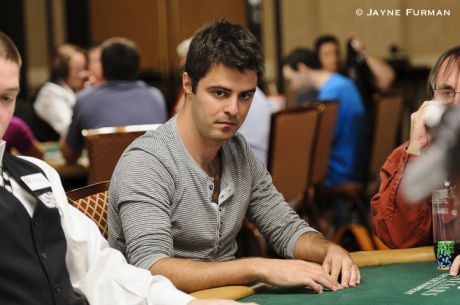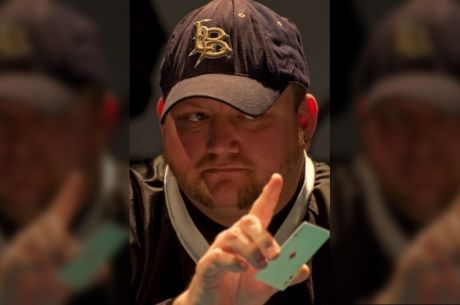Hand Histories: 50 Years of Debate Over the Last Hand of “The Cincinnati Kid”
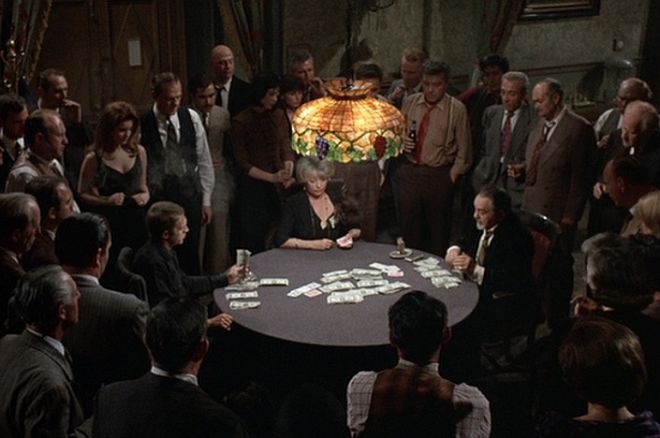
Table Of Contents
Fifty years ago today — on October 15, 1965 — came the premiere of a film that a half-century later remains one of the best poker movies ever made, The Cincinnati Kid.
Based on a short, pulp novel by Richard Jessup, the film directed by Norman Jewison stars Steve McQueen as poker player Eric Stoner, a.k.a. “the Kid,” who after an extended period of dominating poker games against locals is eager to challenge the player known as “the Man,” Lancey Howard, portrayed by Edward G. Robinson.
The two characters’ nicknames unsubtly suggest one of the film’s more obvious themes — the “coming of age” story in which the younger Eric is shown to learn a lesson of sorts after going up against the experienced Lancey. That point gets emphasized in the final scene when Lancey delivers a series of memorable lines to Eric, including one in which he refers to the last hand of five-card stud the pair played.
“Gets down to what it’s all about, doesn’t it?” says Lancey, looking more than a little devilish as he lights a cigar. “Making the wrong move at the right time.”
The Kid sounds less than convinced when he responds with a question: “Is that what it’s all about?” “Like life, I guess,” continues the Man, somewhat inscrutably.
The hand the pair has just played is perhaps the most famous in any poker movie — indeed, one of the most famous in poker, period. It’s certainly one that has earned the most debate, for a variety of reasons.
The Hand
(Fifty years would seem like enough time to make the “spoiler alert” warning no longer obligatory, but know that in what follows the film’s ending is thoroughly given away.)
The game is no-limit five-card stud, appropriate for the film’s Depression-era setting. Incidentally, while the novel is set in St. Louis during the 1950s, the film pushes the story back a couple of decades and moves it to New Orleans, thought by many to be the birthplace of poker.
In five-card stud players initially receive one card down and one card up, followed by the first round of betting. From there they each receive three more cards one at a time, all face up, with betting after each deal. In the end, then, four of each player’s five cards are shown.
By the time the final hand arrives, other players originally involved in the game have dropped out to leave just Eric and Lancey to battle heads-up, and the Kid appears to be having the best of it. A montage shows him winning several hands in a row, with shots of Lancey rubbing his forehead and loosening his collar suggesting the Man is starting to wear down physically, if not mentally, too.
Lady Fingers (portrayed by Joan Blondell) — brought on to deal by Eric after he has discovered the original dealer, Shooter, has been trying to cheat for him — shuffles and deals. Eric’s up card is the 10♣ while Lancey has the 8♦ showing, meaning Eric acts first. He bets $500, and the Man calls.
The next round sees Eric pick up the 10♠, pairing his ten, while Lancey is dealt the Q♦. Eric leads for $1,000, then despite his opponent’s pair showing Lancey raises to $2,000. “I’ll just call,” says Eric. There’s now $5,000 in the middle.
On fourth street Eric is dealt the A♣ while Lancey gets the 10♦. “Three diamonds and a possible,” says Lady Fingers when describing Lancey’s board as he has a possible flush draw going. The Kid bets $3,000 — 60% of the pot — causing onlookers to sit up and murmur loudly. A couple are shown speculating that the Man is “going for the flush.”
“A reasonable bet,” says Lancey, who then places forward the cash needed to call. “Deal the cards,” he says to Lady Fingers. Pot is $11,000.
She tosses Lancey the 9♦, noting the possible flush and the possible straight flush. She then deals Eric his last card, the A♠, saying “two pair” then indicating Eric is to act first.
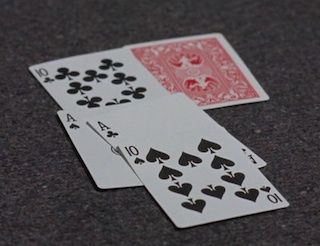
The Kid: Xx 10♣10♠A♣A♠
The Man: Xx 8♦Q♦10♦9♦
Both players have scary boards. “Check to the possible,” says Eric, and Lancey wastes no time making a small bet of $1,000.
The Kid doesn’t hesitate either. “Calling your thousand and raise... what I’ve got in front of me,” he says (string-raising as they always seem to do in the movies). He has $3,500 behind, so the total bet is $4,500.
“That ace must have helped you, Kid,” says Lancey, who nonetheless collects bills together to reraise. “Call your thirty-five hundred and raise... five thousand,” he says, fishing money out of his wallet (and showing that “table stakes” doesn’t apply here).
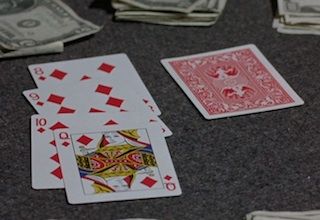
There is now $25,000 in the middle. The spectators excitedly speculate over whether or not the Man is bluffing or has the jack of diamonds in the hole. They’re leaning toward a bluff. We get to hear a little internal monologue by Eric, telling himself “I got him! I got the Man!”
The Man offers to give the Kid a marker to cover the $5K more. Finally the Kid calls, indicating he’s doing so by saying “let’s see it.”
The Man promptly turns over the J♦ — a straight flush. “That’s five thousand you owe me, Kid,” he says without any expression.
“You raising tens on a lousy three-flush,” smirks Lady Fingers to Lancey, alluding to the Man’s raise on third street. Meanwhile a dazed Kid shows his down card — the A♥ for a full house.
The Debate
As noted, it’s likely the most discussed poker hand in film history, occasionally derided by some for being so improbable that it tends to undermine what is otherwise a very realistic plot and portrayal of the game.
“In poker terms, the hand is a joke,” declares Anthony Holden in his excellent poker memoir Big Deal: A Year as a Professional Poker Player first published in 1990. In Poker: Bets, Bluffs, and Bad Beats (2001), Al Alvarez echoes the sentiment when after praising the film he admits “authentic poker only goes out of the window at the final showdown.”
Holden cites the odds against a straight flush beating a full house in a two-handed game of five-card stud, noting how with Lancey holding one of the tens the chances are even more “laughable” — “well over 300 billion to 1 against.” He estimates that “if these two played fifty hands of stud an hour, five days a week, the situation should arise once every 443 years.”
He goes on to refer to poker author Michael Weisenberg’s discussion of the hand and another implausibility, namely the fact that the Kid doesn’t suspect any foul play occurring between Lady Fingers and the Man. While those two do have a history, the film doesn’t provide any concrete evidence of cheating having occurred.
For Holden and others, the implausibility of the hand gets in the way of the film’s moral. “You’re good, Kid, but as long as I’m around you’re second best,” says Lancey, pointing a finger in Eric’s direction. “You might as well learn to live with it.”
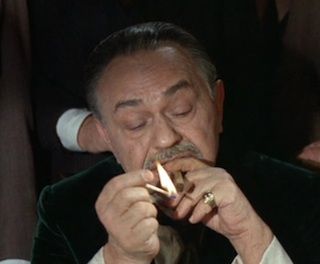
But does the hand unambiguously demonstrate the Man’s better skill — or the importance of experience? Or was it all just a matter of luck — of “making the wrong move at the right time”?
Set aside for a moment outrage over straight flushes beating full houses in the movies. (Remember Casino Royale?) In other words, forget for a moment about the luck of the draw and instead think about the skill exhibited by the players in the hand.
As Lady Fingers points out, the Man’s raise with three diamonds and no pair when he can see the Kid’s pair of tens showing is an interesting semi-bluff. What do you think of that play?
The Man’s call on the next street is also worth exploring. He calls $3,000 to win $8,000, still with no pair but with a flush draw, a gutshot to a straight, and of course a one-outer to a straight flush. Meanwhile he sees the Kid’s pair of tens and an ace, with two pair more likely than three of a kind given that the Man has one of the tens. What is your opinion of the Man’s fourth-street call?
Betting on the final street provides still more interesting strategic decisions. What do you think of Kid’s decision to go for the big check-raise with his full house? What about his call of the Man’s reraise? These are points at which some have suggested that despite the Kid’s having been the victim of bad luck, he might have played the hand better, too.
What do you think of the final hand of The Cincinnati Kid? Share your comments below as we begin another half-century of discussion about the hand.
Want to stay atop all the latest in the poker world? If so, make sure to get PokerNews updates on your social media outlets. Follow us on Twitter and find us on both Facebook and Google+!

